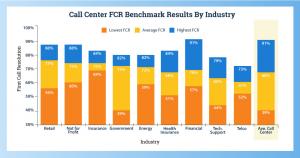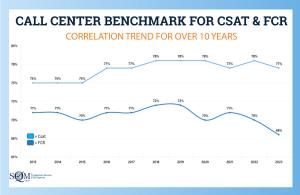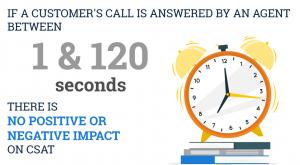The Call Center Industry 2023 Benchmark Results for the Top Metrics and KPIs
VERNON, BC, CANADA, July 27, 2023/EINPresswire.com/ --
Call Center Benchmarks
Learn how a call center compares with its industry peers, the industry average, and world-class performers for the top call center benchmarks and industry standards. The top call center benchmarks include metrics and key performance indicators (KPIs) such as First Call Resolution (FCR), Customer Satisfaction (Csat), Service Level, Average Handle Time (AHT), and Agent Turnover.
10 Call Center Benchmarks
Based on benchmarking over 500 leading North American call centers for the top call center benchmarks, a call center's or team's performance can be compared to the industry benchmark average and industry standards.
In this blog, we define call center benchmark as the average performance for the call center industry for a specific metric and industry standard as to what is considered good performance for a specific metric.
This blog discusses the below top 10 metrics, KPIs, benchmarks, and standards for 2023 to ensure that a call center is on track to deliver great customer service efficiently and effectively. So, let's get started:
1. First Call Resolution
2. Customer Satisfaction
3. Average Handle Time
4. Service Level
5. Agent Turnover
6. Agent Utilization
7. Abandoned Calls
8. Callers Put on Hold
9. Call Transfers
10. Complaint Calls
1. First Call Resolution Benchmark
Based on a post-call survey standardized method, the call center benchmark for the First Call Resolution rate is 68%. The FCR rate means that 32% of customers must recontact the organization about the same inquiry or problem.
SQM Group's research shows that the number one thing customers want from call centers is a fast resolution for resolving their inquiries or problems. Furthermore, that is why FCR, Average Handle Time (AHT), call hold, and transfer rates are essential metrics to benchmark.
The call center industry standard for a good FCR rate is 70% to 79%. Therefore, call centers with an FCR rate below 70% need improvement. Conversely, the world-class FCR rate is 80% or higher, and only 5% of call centers can achieve the world-class FCR rate from a customer experience (CX) journey perspective.
The aggregated FCR average across all industries for 2023 is 68%. The call center industry's FCR rate ranges from 39% to 91%. The average FCR has been 3% lower since COVID-19, with each industry showing a lower FCR in 2023 (1% to 4%) since Pre-COVID-19. The lower FCR in most cases can be attributed to the all-time high agent turnover, job burnout, and work-from-home (WFH) challenges.
2. Customer Satisfaction Score Benchmark
Based on a post-call survey standardized method, the call center benchmark for the customer satisfaction score is 77%. The customer satisfaction Csat score means that 77% of customers are very satisfied (top box survey rating response) with the call center's overall customer service.
The call center industry standard for a good Csat score is 75% to 84%. Therefore, call centers with a Csat score below 75% need improvement. Conversely, the world-class Csat score is 85% or higher; only 5% of call centers can achieve a world-class Csat score. The Csat score also varies by call type, line of business (Lob), and industry.
As benchmarked by SQM Group, the call center industry FCR is 68% for 2023, down 4% since COVID-19. Interestingly, FCR for 2020 was 70%, the first year of COVID-19, when most employees started to work from home (WFH).
The correlation of FCR to Csat remains high. Since 2012, when FCR goes up or down, so does Csat. However, a trend in recent years is that the gap between FCR and Csat has started to widen. For example, 2012, the FCR and Csat gap was 4%. Conversely, the FCR and Csat gap was 9% in 2023.
SQM's view for why the FCR and Csat gap has been widening in recent years is increased call complexity due to higher usage of self-service touchpoints (e.g., website, chat, IVR) and the after-effects of COVID-19 impacts. For example, customers do not punish call centers with lower Csat as much as they used to when not experiencing FCR. Many customers recognize that their complex call has made it more challenging for a call center to deliver FCR.
3. Average Handle Time Benchmark
The call center benchmark for AHT is approximately 10 minutes for call centers handling customer service calls we benchmarked. However, other companies report the industry standard for a good AHT to be 5 to 7 minutes for inbound call centers that handle customer service calls. Furthermore, the AHT can significantly vary depending on call type, LoB, and industry.
The average handle time metric measures the average time for an agent to resolve a customer issue or problem. AHT (i.e., agent talk time + hold time + after-call task time) starts when an agent answers the customer's call and ends after wrapping up the call.
It's also essential to consider that AHT should not be prioritized at the expense of quality customer service. While efficiency is essential, providing excellent support and resolving customer issues thoroughly should remain the primary goal.
SQM's research shows that the AHT (i.e., talk time, hold time, and wrap-up time) for the call center participating in our benchmarking study is 589 seconds, resulting in an 8% increase from the previous year. Furthermore, our research shows a steady increase of 5% or more for AHT in the last five years.
4. Service Level Benchmark
The call center benchmark for service level is typically 80/20. This means that 80% of incoming calls should be answered by a live agent within a specific target time (usually measured in seconds). SQM research shows that 71% of call centers achieve the 80/20 standard 80% or more of the time.
It's worth noting that service level benchmarks can vary across industries, organizations, and regions. Some call centers may aim for higher service levels, like 90/10 or even 95/5, depending on the nature of their business and the level of customer service they want to provide.
The call center industry standard for a good service level is to answer 80% of calls in 20 seconds. The target time may vary depending on the organization's service level agreement (SLA), but it is often set at around 20 seconds.
SQM research shows in most cases that, there is no Csat penalty for calls answered within 120 seconds. Put differently, if a customer's call is answered by an agent between 1 and 120 seconds, there is no positive or negative impact on Csat. Calls that take longer than 120 seconds to reach a live agent have a negative impact on overall call center Csat.
5. Agent Turnover Benchmark
The call center benchmark for agent turnover is 38%. In 2022 annual agent turnover percentage was at a historically high level for the call center industry, and there are no signs of lowering in the near future.
Before COVID-19, the call center industry standard for annual agent turnover was 20% or less. A more accurate standard for annual agent turnover in 2023 would be below 30%. It is not uncommon for world-class performing FCR and Csat call centers to have 20% or less annual agent turnover.
Furthermore, agent turnover is the biggest issue hindering call centers in terms of cost and customer service. Therefore, the call center needs to improve agent turnover to ensure a sustainable work-from-home (WFH) model and good Csat. As a result, SQM believes agent turnover is the number one challenge facing call center industry leaders.
The high agent turnover percentage is staggering, but they don't tell the entire story. SQM's 2022/23 benchmarking data shows some call centers have agent turnover as low as 20% and as high as over 200%. In addition, compounding the agent turnover issue is that 81% of agents prefer the WFH, 16% want the hybrid model, and only 3% prefer the call center. By all accounts, the WFH model has been one of the main contributors to high agent turnover.
6. Agent Utilization Benchmark
The Call Center Benchmark for Agent Utilization Rate is 81%. The agent utilization rate refers to the percentage of time that an agent spends actively handling customer inquiries, problems, or after-call tasks, compared to their total available working time. It is commonly used in customer service call centers. The call center industry standard for a good agent utilization rate is between 75% and 85%.
There is a general belief among call center leaders that high agent utilization rates (above 85%) are not sustainable for long periods. An 85% or higher occupancy rate for most agents feels like a sweatshop working environment.
Furthermore, higher agent utilization rates mean that agents have very little time between calls, and this can cause a lot of stress, especially if they are handling a lot of non-FCR and dissatisfied customers. In addition, given the record-breaking agent turnover rate and the high percentage who feel burnout, agents need to be below the 85% utilization rate.
It’s essential to strike a balance between high utilization and agent well-being, as excessive utilization can lead to higher turnover and decreased Csat. However, lower agent utilization can create an unhealthy or what some describe as a lazy working environment.
7. Abandoned Calls Benchmark
The Call Center Benchmark for Abandon Rate is 6%. The call center abandon rate refers to the percentage of callers who hang up or disconnect before speaking to a live agent. A lower abandon rate is generally preferred as it indicates that callers are willing to wait for assistance, resulting in better customer satisfaction and potentially more successful resolutions.
The call center industry standard for a good abandoned calls rate is 5%. Generally speaking, call center abandonment rates of less than 5% are considered good. Sometimes, it is acceptable if the rate is between 5% and 10%.
However, if the rate is over 5%, in most cases is viewed as too high. The call abandonment rates can vary depending on the industry, call reason, line of business, time of day, and day of the week. Furthermore, most call centers with great Csat have a 5% or less call abandon rate.
It is essential to mention that the false abandoned calls rate happens within the first 10 seconds of a call and represents up to 2% of call volume. Therefore, the abandoned calls rate calculation should include calls abandoned within the first 5 or 10 seconds criteria for accuracy and benchmarking purposes.
Customers who have abandoned a call and then called back the call center for the same reason and their call was resolved do not consider it FCR and tend to have lower Csat.
8. Callers Put on Hold Benchmark
The call center benchmark for callers put on hold is 46%. Most callers put on hold are told that they are being put on hold; the average on-hold length is 55 seconds. A good call center industry standard for callers being put on hold when talking to an agent is 35% or less of the call volume.
Best practices suggest that businesses should try to minimize hold times and provide alternatives such as call-back options or self-service solutions to reduce customer frustration. The ideal hold time can vary between industries and organizations, but generally, keeping it under a minute is a good goal.
SQM research shows that there is a significant difference in Csat and FCR for customers put on hold compared to customers not put on hold. When customers are put on hold, Csat (top box response) is 13% lower, and FCR is 16% lower than when customers are not put on hold.
Customers prefer a live hold practice, meaning that the customer can talk to the agent at any time versus being put on mute and not speaking to the agent. Another important finding from SQM's research for live hold is that the average handle time is shorter with a live hold versus a mute hold. The main reason is that the agent has more urgency to resolve the call when the live hold business practice is being used.
9. Call Transfers Benchmark
The call center benchmark for call transfers rate is 19%. Most customers only want to talk to one agent and preferably the first one they reach. A good call center industry standard for caller's calls being transferred to another agent or supervisor is 15% or less of the call volume. The effectiveness and efficiency of call transfers can be essential for customer satisfaction and overall call center performance.
SQM research shows that when a customer is transferred, Csat (top box response rating) is 12% lower, and FCR is 14% lower than when a customer is not transferred. The main reason why customers are transferred to another agent is that the IVR voice menu system did not route the customer to the right agent in the first place, or the agent's knowledge, skills, and abilities are poor.
Customers appreciate a warm transfer because they do not have to repeat their information to the new agent. However, what further enhances the CX is when there is no wait time to reach the appropriate agent. But what customers really want is the agent that they first speak with to handle their call without a transfer.
10. Complaint Calls Benchmark
The call center benchmark for customer complaint calls percentage of volume is 14%. 58% of call centers report that customer complaint calls represent 10% or less of call volume.
However, many call centers underreport the percentage of calls that callers would describe as complaint calls. A good call center industry standard for callers who describe their call as a complaint is 10% or less of the call volume.
Most call centers are not effective at handling customer complaint calls. In addition, many call centers do not have a complaint call definition. Therefore, it is no surprise that call centers are inconsistent in identifying, tracking, and resolving customer complaint calls.
Unfortunately, SQM research shows that only 5% of call centers provide world-class service recovery Csat standard of 75% (top box Csat survey response). Moreover, we would describe most call centers with a service recovery program as somewhat effective but not good. For example, the average call center service recovery Csat (top box Csat survey response) is 47% versus world-class call centers; the Csat average is 77%.
Furthermore, 88% of customers have stopped doing business with a company because of poor call center customer service. Therefore, service recovery aims to convert dissatisfied customers to satisfied ones, so they will likely continue using a company's products and services.
It's important to note that complaint calls benchmark can vary based on the metrics used, industry, company size, and customer expectations. Therefore, setting benchmark targets based on historical performance, industry standards, and customer feedback is crucial. Additionally, continuous monitoring, analysis, and improvement of these metrics are essential for maintaining and enhancing call center performance.
Mike Desmarais
SQM Group Inc.
+1 778-581-8243
email us here
Visit us on social media:
Facebook
Twitter
LinkedIn
Other
![]()





